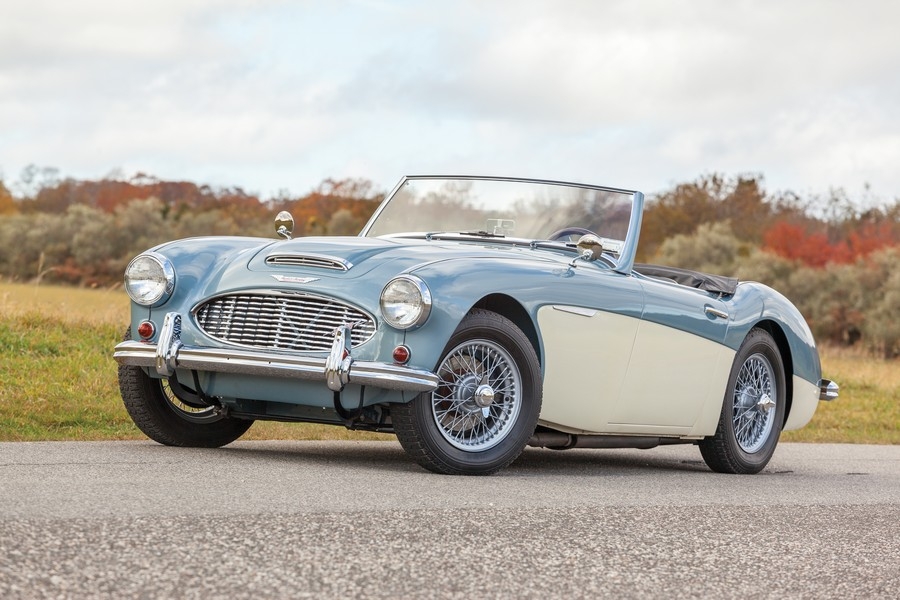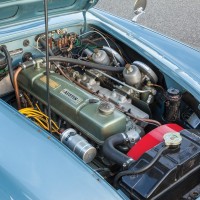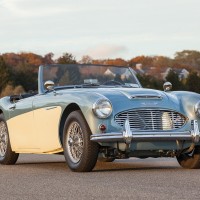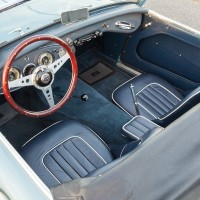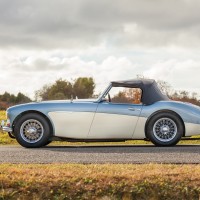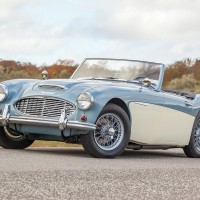Following the debut of the original 4-cylinder Austin-Healey 100 in 1952, and the subsequent change to the 6-cylinder 100-6 in 1956, the British Motor Corporation in 1959 launched the car that would become the defining model of the range: the 3000. As it had a 3-liter engine that could produce 124 horsepower, it was the most powerful “Big Healey” yet, and BMC undertook an ambitious competition program to demonstrate its prowess in circuit racing and in the grueling European road rallies.
It is this very model, the two-seat 3000 Mk I, that fired the imagination of sports car enthusiasts around the world with victories in the most punishing events of the time. This is the model that Pat Moss, sister of Sir Stirling Moss, drove to an astounding 1st-place overall victory in the brutal and legendary 1960 Liège-Rome-Liège Rally. It is also the model in which she won the Coupe des Dames at the Geneva Rally in 1960 and the Ladies Cup at the Tulip Rally the following year.
Likewise, the Morley brothers, Don and Earle, scored an outright victory in the 1960 Alpine Rally in a two-seat 3000. Another factory team car finished 2nd in class in the 1960 12 Hours of Sebring, where it was bested only by a Ferrari 250 GT California.
This model is prized by collectors for its no-compromise two-seat design, as it doesn’t have the family-car pretenses of the concurrent four-seat model. It is also cherished for its rareness, as only 2,825 of the 13,650 total 3000 Mk I production, just 20%, were two-seat models. With production of the Mark I beginning in March 1959, this car, with a May 25–26, 1959, build date, is among the earliest examples of the model, further adding to its allure and collectibility.
When it was originally dispatched to Chicago on June 4, 1959, it was equipped with all of the options available, which included the Laycock de Normanville overdrive. The overdrive, engaged by a toggle switch on the fascia, operates on third and fourth gears to produce a total of six gear ratios, which makes long-distance cruising comfortable and leisurely.
This car was also equipped with wire wheels and road-speed tires, a laminated windshield, a heater, and an adjustable steering column, adding to the overall style and driving comfort of an already capable machine. These original manufacturing details, verified by the Heritage Certificate, provided the blueprint for the current restoration and are included in the car today. This car is equally at home on mountain and country roads, as the Mark I’s 162 foot-pounds of torque gives it brisk performance anywhere, while also still covering over 20 mpg.
This example has traveled only approximately 500 miles since the completion of a professional ground-up, frame-off, bare-metal restoration. Photographs during and after the restoration process, as well as the original steering wheel, are also included. The quality restoration work shows a devotion to absolute authenticity, as NOS parts were applied, when available, and only the finest materials, paint, and bodywork were used. All rubber parts are new, as is the wiring harness, leather interior, top, carpets, chrome, side curtains with storage bag, and lead/bronze wheel hammer. Since the restoration, it has been properly maintained and inspected, and it is in immaculate condition.
The sale of this rare car, which has been finished in what many consider to be the quintessential Big Healey color scheme of Healey Blue and Ivory, has benefited from a complete and correct restoration. It offers an outstanding opportunity to own a classic, defining example of the marque, and it is one that is in superb condition.
SCM Analysis
Detailing
| Vehicle: | 1959 Austin-Healey 3000 Mk I BN7 |
| Number Produced: | 2,825 |
| Original List Price: | $3,051 |
| Distributor Caps: | $25 |
| Chassis Number Location: | Stamped on a rectangular aluminum plate attached to the firewall in the engine compartment |
| Engine Number Location: | Embossed on an aluminum plate riveted to the left side of the engine block |
| Club Info: | Austin-Healey Club of America |
| Website: | http://www.healeyclub.org |
| Investment Grade: | B |
This car, Lot 117, sold for $88,000, including buyer’s premium, at RM Auctions’ Amelia Island, FL, sale on March 8, 2014.
While many collectors focus on the Austin-Healey 3000 Mark III, series BJ8, as the most civilized, most luxurious and most spouse-appealing model of the line, it is the 3000 Mark I that really defined the marque and catapulted it from its status as a merely popular sports car to the stuff of legend.
The first Big Healeys — the 4-cylinder 100, 100M and 100S — were successful enough and earned a respected place among sports cars, but despite publicity-gaining efforts on the Bonneville Salt Flats and in several important races in the mid-1950s, they were never world-beaters. They were often class winners, yes, but seldom first overall.
Stumbling and recovering
With the production of the follow-on model, the 100-6, the Big Healey briefly lost its way as a road car capable of respectable performance in competition. Initially, the 100-6 was available only as a 2+2, a configuration meant to increase appeal to young families, but performance suffered and competition successes were few.
However, BMC recaptured the Healey’s mojo and took it to new levels when they added a strict two-seat model, soon followed by their increased competition efforts on the European road-rally circuit. These punishing contests of endurance on extremely challenging roads — some of which hadn’t been improved since well before World War II — offered the Big Healey a venue more suitable to its character, that of a tough, durable “hairy-chested” sports car. It’s no surprise that a later book about them was titled The Handsome Brute, and at one point BMC even adopted the advertising slogan “The Last Angry Car.”
Winning races and fame
By the time the 3000 was launched in 1959 with both 2+2 and two-seat variants, it was the strict two-seater that was chosen for competition use. The corporate commitment to competition, while modestly funded, was ambitious, and it produced huge publicity as the two-seat 3000 began a string of impressive performances that elevated the marque to world-beater status and captured the imagination of the sports car-buying public.
This example of the two-seat 3000 is a virtual poster-car; an archetype in its classic Healey Blue and Ivory White two-tone paint scheme. If we have to cite something that needs correction, it would be only to remove the orange front turn-signal lenses and replace them with the correct clear lenses.
All the money — but worth it
While selling for well above the SCM Price Guide maximum of $60,000, this example was the subject of a recent complete restoration to a high standard. The authenticity even extended to keeping the correct 48-spoke painted wire wheels — a rare example of resisting the urge to add bling via 60- or 72-spoke chrome wheels.
For Austin-Healey fans, this is a superb example of the line, and given its specification, condition and originality, I call it market-correct. ♦
(Introductory description courtesy of RM Auctions.)
